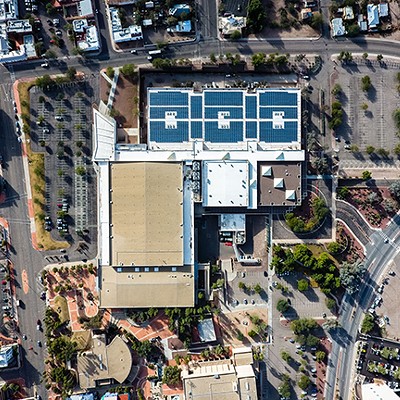On this day it is hot and it is dry. We motor alongside then past the out-of-place greenery of The Gallery, a heralded golf course that is a hallmark of David Mehl's 5,600-acre conversion of the once sparsely populated and still remote Tortolita fan and foothills. David is the Marana Mehl. Despite the rave reviews for the new golf track, The Gallery is not La Paloma, which Mehl dreamed and built with his late brother, George, and with the aid of the state Land Department.
We stop at several points in the many braids that provide a course for Tortolita Mountain runoff when it rains. It's a few days after the last rain. That makes it easier for the machine; its tires can clutch something more solid than sand. The runoff deposits evidence of what environmental activists have been warning Boards of Supervisors about for years. Runoff from golf courses, spiked with fertilizers and pesticides, is toxic to washes and the plants and animals around them. Recent rains created runoff strong enough to carry drainage and irrigation PVC pipe into washes. Golf balls are numerous, deposited by duffers and runoff.
We have two destinations.
Both are surreal and disquieting.
High up, where more homes and more golf will be added to Mehl's Marana, is a patch of once thriving desert that included ironwood trees, cholla, saguaros, mesquite, palo verde, creosote, barrel and other cactus.
Marked off by T-posts and a single strand of wire, it has been scraped bare except for a few saguaros that now have nothing around them. No ironwood. No cover. Just some survey stakes and taller, flimsy alignment poles. Hundreds of ironwoods were chopped down around the same time the drive to preserve ironwoods in a national monument in the Silverbell and Ragged Top mountains was on.
Even to someone not trained in desert ecology, it looks preposterous, like the vision Hollywood--50, 60 and 70 years ago--had of the desert. Dirt and saguaros.
It gets worse. Funereal, in fact.
Covers and carpets are ready for saguaros that developers contend they are saving by transplantation. Others are tagged with notes held by wire or are "tagged" with spray paint in what becomes a saguaro Death Row. One cactus marked for death has a red cross painted on it.
Further perpetuating the desert image of an old Hollywood back lot, saguaros that are not postcard-perfect to developers and their aesthetics consultants are tagged and labeled "diseased." They may no longer be healthy. But they won't die and fall for years and in the meantime provide shelter, cover and food for others in this ecosystem.
Fifteen years before he and his builders added sticks, stucco and red tile roofs at neighboring Dove Mountain, Mehl was gaining all sorts of notoriety for moving saguaros around his pink La Paloma, in the central Santa Catalina Foothills. For a time, the moves were trumpeted, even by the then superintendent of Saguaro National Monument, now Saguaro National Park.
Reality, after the ballyhoo, was much more grim. Transplanted saguaros were not saved. They were dying. Dying in such numbers that born-again NIMBYs such as Scott Alexander, a lobbyist and former Republican state senator, rose to fight a proposed development next to La Paloma six years ago.
OUR JOURNEY, ON A new path that on some days is a small river, continues to a place called Wild Burro Canyon. Here are what monitors say are petroglyphs. Nearby is a saguaro felled by lightning and crashed over a plastic fence. New roads have been cut in here, and protected cactus has been tossed in a heap with ripped-out ocotillo. Environmentalists fear this canyon site will be ruined by a planned resort.
One wash has been lined here with rock. Degradation in this area has brought, at least for the proposed Chaparral Heights development, a strong rebuke from the Environmental Protection Agency.
Well before the start of these drives up the washes, we have crossed political jurisdictions of greatly varying will: Tucson, unincorporated Pima County, Oro Valley, Tortolita (if the courts would allow that preservationist community) and the Mehl haven of Marana.
It is a game of sorts.
Developers blade and grade and clear sometimes in the open. They mark and cut sometimes under cover.
Their opponents watch. They hike, they drive, they blend in with golf carts that are becoming as ubiquitous here as they are in the county-subsidized hamlet of Green Valley. When the suits confront them, they take to the air in ultralights or small planes from nearby Cholla Air Park.
It is not as if the county has stood idly by. After gaining voter approval in May 1986 for seven broad bond proposals, including parklands and flood-prone land acquisition, the county snapped up the sprawling Martin Ranch in the Tortolitas for $3,000 an acre--nearly double what critics thought it was worth. Now the Tortolita Mountain Park contains about 1,300 acres.
Twisting and winding up the arroyos is not unlike following the circuitous path the long line of speculators, their agents, their mouthpieces and their builders have taken in front of various Boards of Supervisors and the Marana Town Council. In some cases, the path has stretched over generations. And when people move or die, speculators reappear to alter or erase what a previous board approved. Some players reappear in new roles.
That is illustrated best by a quarter-century history of a 160-acre slice of the Tortolita foothills that has been cleared for homes.
IT WAS A REZONING FILED in 1973, the first year the board expanded from three to five. It included Democrats Ron Asta, Joe Castillo, Jim Murphy and E.S. "Bud" Walker, and Republican Conrad Joyner.
In December, 23 years later, Robert Stubbs showed up in front of a Board of Supervisors that was in the last throes of Ed Moore's Republican majority. Moore, after three terms, and Paul Marsh, paying the price for allegiance to Moore after only one term, were packing their bags. Republican Mike Boyd hung on thanks to incompetent opposition, and Democrats Dan Eckstrom and Raúl Grijalva were holding their positions.
Petulant, strident and smart, Stubbs has been a top land-use lawyer in Tucson for decades. His partner, Larry Schubart, also is a land-use expert who received part of his training in the County Attorney's office. Schubart has been so close to Moore that he loaned the supervisor thousands of dollars when Moore, also a real estate speculator, hit hard times after blowing through the riches he got from the sale of land for Estes Homes' Meadowbrook subdivision. Despite his land-use specialty, Schubart, a year before the Tortolita rezoning, had collected on a huge bill, $600,000, doing little to defend Moore and his allies in the successful lawsuit filed by some county officials that the Moore majority fired.
The 80 homes on 80 acres on part of that rezoning were not good enough, Stubbs told the supervisors that December morning in 1996. He wanted 150 homes. Stubbs had an interest in the land and also represented partners. His planning consultant was Alex Garcia, who had seen this parcel when he was director of county Planning and Development. A former board legal adviser, Jim Hillock, also showed up to urge approval for what Stubbs wanted.
Moore did not listen, at least not from the dais. He sat in a back room drinking cup after cup of bad coffee, talking to others and eating pastries.
Just as well. Samuel Winchester Morey, an activist whose presentations became so regular that "Citizen" was added to his name, lashed Moore for his disrespect and noted that he found the property to be owned by the family, one of C.J. Scott.
Scott, an alias for James Henry Patterson, was a Moore backer, contributing $440 to Moore's reelection campaign in 1992. Patterson was in prison at the time of the 1996 rezoning hearing. He had jumped bail in 1980 after conviction in Nevada for auto theft, transportation of stolen vehicles and conspiracy. As C.J. Scott, the developer, he was fined $5,000 for two counts of illegally excavating a Hohokam archaeological site that he deemed in the way of one of his Tortolita subdivisions.
Despite Citizen Sam's good memory, Stubbs and the board sidestepped the issue.
Stubbs rambled, often with the help of embarrassingly leading questions from Boyd. Opposition came from the usual suspects: Carol Duffner, a neighborhood activist who has made a living with the help of transcription contracts from the county, and Joe Murray, a handyman who was part of the Northwest Coalition for Responsible Development.
Moore emerged after the testimony, took his seat and saved Stubbs' day. He moved that the change be granted, "but at the same time, require that ironwoods and saguaros be saved on the property as the lots are put together."
"I know it can be done," Moore said.
Marsh, true to his "dim bulb" and "el segundo" nicknames, quickly seconded Moore's motion. Stubbs did his dance, confusing the issue by misstating the number of a zoning condition while seeking a far weaker provision on wash protection and erosion control.
Moore fixed it for him with a quick amendment.
"I have no problem with that, but I don't want the ironwoods moved," Moore said.
Jim Mazzocco, a longtime county planner, sought emphasis.
"The ironwoods would have to stay in place," Mazzocco said. "They would have to build around the ironwoods."
Moore: "Yeah, right."
Mazzocco: "Is that clear?"
Marsh: "Does everybody agree with that?"
Stubbs: "I don't know. We would have to make an announcement. It might be necessary to move some of them, but ..."
Moore: "You can't move them. That's the problem."
Moore's fix passed 4-1 with Grijalva, in his standard elocution, voting "Nope."
Moore was right.
You can't move ironwoods.
They, instead, were hacked.












